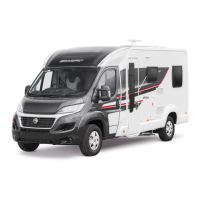Electrical Systems
D) Check Residual Current Device
operation. Locate the RCD within the
PSU2007 and ensure the RCD is switched
on (lever in up position). Press the ‘TEST’
button and confirm that the RCD is turned
off (lever in down position). Switch the
RCD back to the on position (lever in up
position). If the test button failed to
operate the RCD see section 3.4.
E) Check correct Polarity. Locate the
‘Reverse Polarity’ indicator on the
PSU2007 and ensure that the indicator is
NOT illuminated. If the indicator is
illuminated see section 3.4.
F) Check Miniature Circuit Breakers.
Locate the MCB’s within the PSU2007
(adjacent to the RCD) and ensure they are
all in the ON (up) position. If any MCB’s
fail to latch in the on position see section
3.4.
G) Turn the PSU2007 ON. Locate the red
power switch on the PSU2007 and turn to
the ON (I) position. The switch will
illuminate when turned on.
H) Check operation of equipment. It is
now safe to check the operation of the
12v and 240v equipment.
3.3 BATTERY
A) Type / Selection
For optimum performance and safety it is
essential that only a proprietary brand
LEISURE battery is used with a typical
capacity of 75 to 120 Ah (Ampere / hours).
A normal car battery is NOT suitable.
It is recommended that the leisure battery is
always ‘in circuit’ when the system is in use.
The battery feed is fitted with an inline fuse
between the battery and the electrical
harness, and is usually located immediately
outside the battery compartment or within
500mm of the battery. The maximum rating
of this fuse is 20A.
B) Installation & Removal
Always disconnect the 240v mains supply
and turn the PSU 2007 charger switch to the
OFF (0) position before removing or installing
the battery.
When connecting the battery, ensure that the
correct polarity is observed (black is negative
[-] and red is positive [+]) and that the
terminals are securely fastened. Crocodile
clips must not be used.
WARNING: Explosive gases may be
present at the battery. Take care to
prevent flames and sparks in the vicinity
of the battery and do not smoke.
C) Servicing
Under normal circumstances it should not be
necessary to remove the battery other than
for routine inspection of the terminals and
“topping up” of the battery fluid where
applicable. Please see instructions supplied
with the battery.
Note: Do not over-discharge the battery.
One of the most common causes of battery
failure is when the battery is discharged
below the recommended level of
approximately 10.5v. Discharging a battery
below this figure can cause permanent
damage to one or more of the cells within
the battery.
38

